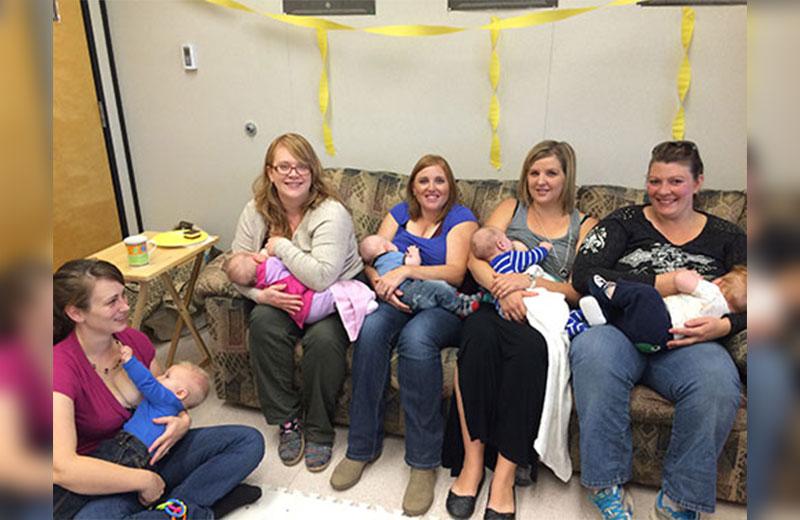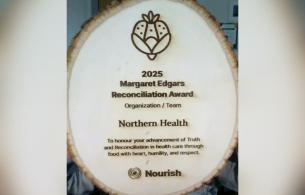Living in one of Northern BC's smaller communities, you may not expect to be able to access globally-recognized, high quality training opportunities for free, right on your own doorstep. Yet this is exactly what a very successful initiative in Quesnel has been able to do.
The Baby Friendly Advisory Committee (BFAC) worked to successfully increase rates of initiation for breastfeeding at GR Baker Memorial Hospital in Quesnel. They recently widened their focus to increasing breastfeeding duration support in the community.
Benefits of breastfeeding
The benefits of breastfeeding exclusively for the first six months of life are well researched, with numerous health benefits for mother and baby. The goal is to increase the number of babies who are exclusively breastfed for the first six months of life (as recommended by Health Canada). Exclusive means that they receive nothing but breast milk until they are six months old (i.e., no solid foods, no water or breast milk substitutes) unless it is medically necessary. In order to meet this goal, the Baby Friendly Advisory Committee felt it was important to engage the community to support breastfeeding mothers. So, in November 2015, they offered a three day training using the World Health Organization breastfeeding course – a required course for every maternity nurse.
Breastfeeding course
The three day course was held at the Quesnel and District Child Development Centre – a child-friendly space. "The room had couches and tables and a kitchen for the participants – which included five breastfeeding moms as well as eight interested service providers," says Bev Barr, Pregnancy Outreach Program Coordinator and BFAC co-chair, who was tasked with coordinating this initiative. "It was originally planned for April but we decided to postpone until November and commit to advertising and promotion."
The group was determined to address potential barriers that are unique to breastfeeding moms. The final plan, in order to make the training accessible, included making the course free, choosing a location with free parking, making sure healthy lunches and refreshments were provided and – of most importance – ensuring child care arrangements for breastfeeding moms were in place. As a result, the final group included five breastfeeding moms among the attendees. "We all learned about breastfeeding while holding babies."
"We had no idea how this would go," says Bev, "and I was incredibly overwhelmed at how positive the response was, especially during that first day because of the high level of technical information. That day is very medically-focused, covering the physiology of breastfeeding, the nutritional composition of breast milk, and the health benefits to mother and baby. The next two days look at more practical issues and problem solving. The participants loved it all! At the end of the first day, they were talking about how much they hadn't known and how much more they wanted to know."
"What we have now is a well-informed and knowledgeable cohort who can support success in initiation and duration of exclusive breastfeeding in the community. Already we have heard three service providers say they are using the information in every visit. The course, in some ways, is bringing back networks of breastfeeding support that used to exist in many families and communities. It's vital we have this capacity and knowledge in the community."
Population health approach
It strikes me, as I reflect on my conversation with Bev, that this small, impactful project exemplifies some of the most important principles of Northern Health's population health approach. The population health approach argues we need to get "upstream" on the river of diseases and causes of poor health in Northern BC. That is, addressing risk factors before they cause ill health is preferable to treating symptoms later on.
What are the principles shown by the BFAC project?
Do it right, not fast was obvious in the decision to wait and build readiness and interest in the audience group. Share what you have to offer and let the group do the work was evident in the willingness to offer a top-flight training opportunity and trust the group to rise to the occasion.
Understanding and addressing the specific barriers to participation that are unique to the group is also key. In this case, providing food, free parking, comfy chairs and a willingness to have babies in the room addressed a set of barriers that can exclude nursing mothers. Capitalizing on the passion and knowledge professionals can bring was also prominent in this work.
Partnership and collaboration were integral. In Quesnel, Northern Health was present in the room with professional expertise and insights and with concrete supports that addressed barriers to participation. At same time, Northern Health was sitting alongside its community members, learning with the community. Learning together is a way to build strong relationships and new connections that strengthen capacity to address issues of local importance.
Underscoring this, of course, is the passionate commitment of the working group who have dedicated years of service to supporting breastfeeding best practices in Quesnel. The BFAC is collaborative and includes representation from a number of individuals and groups. These torchbearers have lit a fire under the participants. The only request of participants was that they would commit to sharing their new knowledge and implement it in their own personal and professional circles. Many are now inspired and seeking additional training because of this opportunity.
The enthusiastic response of the participants to the training and their willingness to work with the new knowledge has given Quesnel a new and strong cadre of breastfeeding champions. The project also points the way to success. In a quiet and unassuming way, Northern Health professionals showed that partnership and population health are important parts of the good work in and by community to improve the health of Northerners.
- This work was supported in part by an IMAGINE Community Grant. IMAGINE grants provide funding to community organizations, service agencies, First Nations bands and organizations, schools, municipalities, regional districts, not-for-profits, and other partners with projects that make northern communities healthier. We are looking for applications that will support our efforts to prevent chronic disease and injury, and improve overall well-being in our communities.
- Read more IMAGINE Community Grant stories.
- This article first appeared in Healthier You magazine. Find the original story in the Spring 2016 issue.














Comments